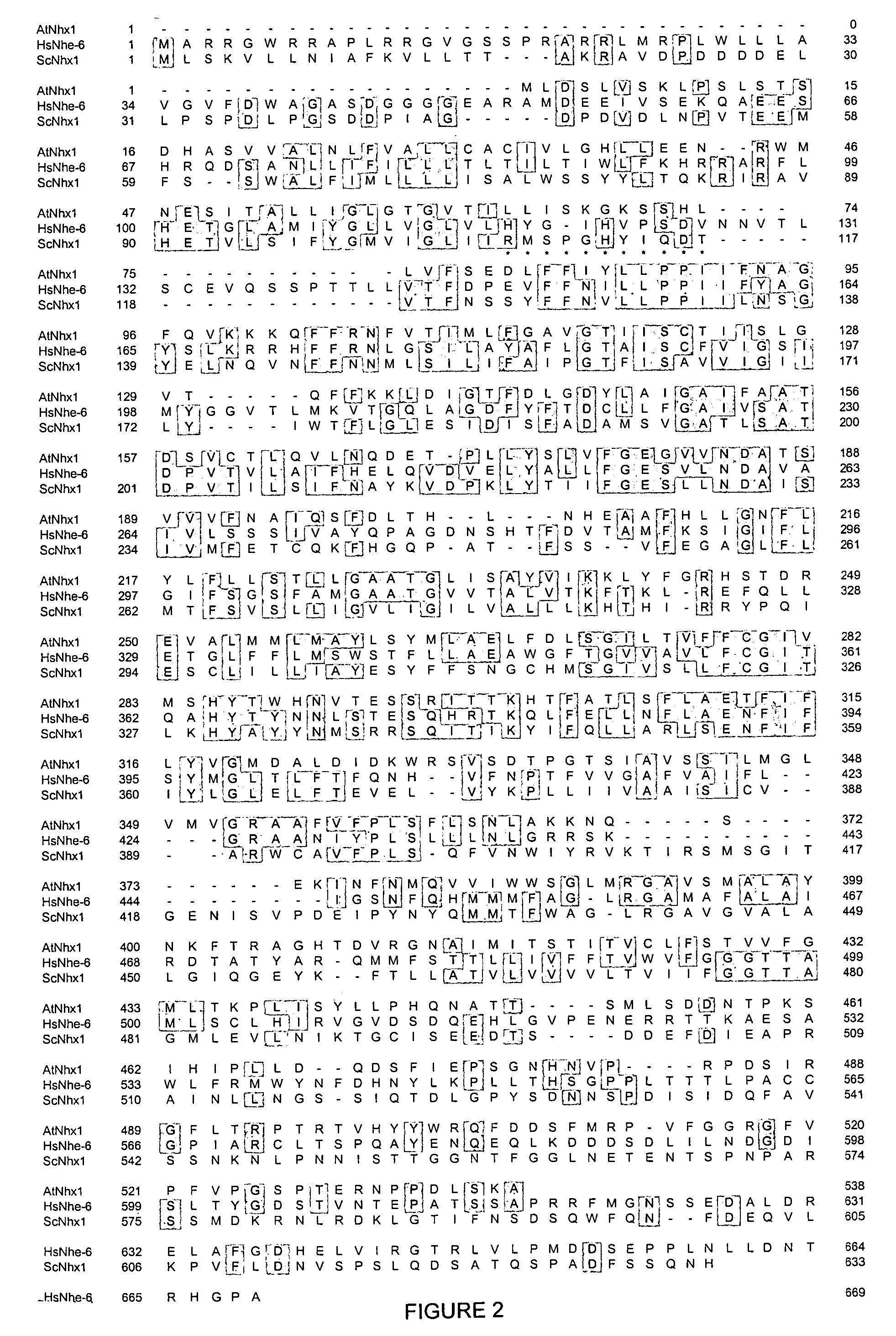Proton transporters and uses in plants
a technology of plant and proton, applied in the field of transgenic plants, can solve the problems of formidable food prospects for humanity as we enter the new millennium, and achieve the effects of increasing flower size, and increasing the yield of plants
- Summary
- Abstract
- Description
- Claims
- Application Information
AI Technical Summary
Benefits of technology
Problems solved by technology
Method used
Image
Examples
example 1
The Arabidopsis Thaliana Proton Transporters, AtNhx1 and Avp1, can Function in Cation Detoxification in Yeast
Materials and Methods
[0043] Yeast strains and Plasmids. All strains used are isogenic to W303 (ura3-1.can1-100 leu2-3, 112trp1-1 his3-11, (Gaxiola, R. A., et al., EMBO J., 11:3157-3164 (1992)). Plasmids pRG52 (Δgef1::HIS3) (Gaxiola, R. A., et al., Proc. Natl. Acad. Sci. USA, 95:4046-4050 (1998)) and pRG197 (Δnhx1::HIS3) were used to construct the deletions of GEF1 and NHX1 genes, yielding strains RGY85 and RGY296, respectively. The ena1::HIS3 mutant was obtained from Fink Lab collection (L5709). Transformation was performed by using the lithium acetate method (Gietz, D., et al., Nucleic Acids Res., 20:1425 (1992)). Double mutants RGY324 (gef1::HIS3 ena1::HIS3), RGY326 (nhx1::HIS3 ena1::HIS3), and RGY343 (gef1::HIS3 nhx1::HIS3) were obtained by crossing the single-mutant strains. Double mutants were identified among the meiotic progeny by scoring for the phenotypes associat...
example 2
Transgenic Plants that Overexpress the AtNHX1
[0072] Transgenic plants that overexpress the AtNHX1 were generated using Agrobacterium-mediated plant transformation. The transgenic AtNHX1 was expressed using a double tandem enhancer of the 35S promoter of CaMV (Topfer, R., et al., Nucl. Acid Res., 15:5890 (1987)). T3 transgenic plants are less affected than wild type controls when watered with 300 mM NaCl.
[0073] 15 wild-type plants and 15 35SAtNHX1 transgenic were grown on a 12 hours-day cycle for 20 days. During this period plants were watered every 5 days with a diluted nutrient solution (⅛ M.S. salts). 200 mM NaCl was added to the watering solution at day 21 and at day 33 plants were watered with a nutrient solution containing 300 mM NaCl. Plants were photographed 10 days after the last NaCl treatment.
example 3
Salt-Stressed Wild Type Plants and 35SAVP1 Transgenics
[0074] Transgenic plants that overexpress AVP1 were generated using Agrobacterium-mediated plant transformation. The transgenic AVP1 was expressed using a double tandem enhancer of the 35S promoter of CaMV (Topfer, R., et al., Nucl. Acid Res., 15:5890 (1987)). 15 wild-type plants and 15 35SAVP1 transgenics were grown on a 24 hours-day cycle for 16 days. During this period plants were watered every 4 days with a diluted nutrient solution (⅛ M.S. salts). 200 mM NaCl was added to the watering solution at day 17 and at day 27 plants were watered with nutrient solution containing 250 mM NaCl. Plants were photographed 10 days after the last NaCl treatment. Identical conditions and treatment as described in Example 2 were used.
[0075] These transgenic plants are larger than wild-type plants. Furthermore, homozygous 35SAVP1 plants show sustained growth in the presence of 250 mM NaCl plus ⅛ M.S. salts when grown in a 24 hours light regim...
PUM
| Property | Measurement | Unit |
|---|---|---|
| temperature | aaaaa | aaaaa |
| pH | aaaaa | aaaaa |
| concentration | aaaaa | aaaaa |
Abstract
Description
Claims
Application Information
 Login to View More
Login to View More - R&D
- Intellectual Property
- Life Sciences
- Materials
- Tech Scout
- Unparalleled Data Quality
- Higher Quality Content
- 60% Fewer Hallucinations
Browse by: Latest US Patents, China's latest patents, Technical Efficacy Thesaurus, Application Domain, Technology Topic, Popular Technical Reports.
© 2025 PatSnap. All rights reserved.Legal|Privacy policy|Modern Slavery Act Transparency Statement|Sitemap|About US| Contact US: help@patsnap.com



